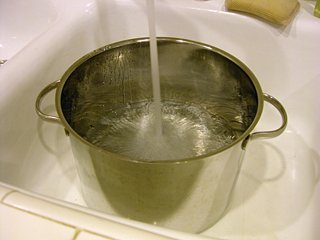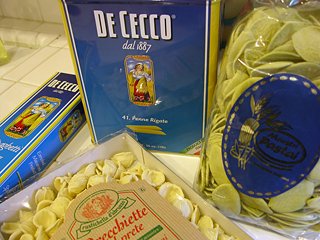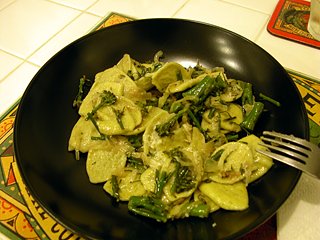How to cook pasta the Italian way
![]() : pasta all'italiana
: pasta all'italiana
What you need
— Good quality pasta
— Condiment of choice
— Rock marine salt
— Cold tap water
— Big pot with lid (e.g. a stock pot)
— Large pan
— Long-handle wooden spoon or fork (or other material that will not melt in boiling water)
— Timer

Directions
- Have everything ready: your pasta measured, your sauce done or 95% done in the pan.
- Fill the pot to about two thirds with water and cover with lid.
- Bring to a rolling boil (big bubbles), then add the salt.
- Wait for the water to start boiling again, throw in the pasta and stir with a wooden spoon.
- As soon as the water starts boiling again, reduce the heat a little to keep the water boiling, but less vigorously and without lid. Now you can do things like set the table, grate the Parmesan cheese, open a bottle of wine, just don't go do your laundry and leave the pot unattended.
- Every couple of minutes or so, stir the pasta with the wooden spoon.
- A couple of minutes before cooking time is over (according to pasta packet instructions or your experience) start testing the pasta.
- When the pasta is nearly done, drain it in a pasta drainer in the sink with cold water running on the side, NOT on the pasta. The cold water is meant to protect any plastic trimmings in your sink pipes. Keep a couple of ladles of the pasta water (to add to the sauce pan).
- Add the drained pasta to the sauce pan, mix in well with the sauce and cook for another minute. Optional: add a little pasta water to the pan to help bond the pasta to the sauce (the starch in the pasta water will do that).
- If your dish calls for it, bring freshly grated Parmesan cheese to the table.
Notes
Pasta
Quality: I recommend good "pasta di grano duro" (hard wheat semolina). Some good brands easily available in the U.S. are De Cecco and Rustichella d'Abruzzo. A good quality pasta will not break while cooking or overcook too easily.
Quantity: 80-100 gr for a first course, more if you are making it the main entrée.
Water
Quantity: Pasta needs a lot of space to move around freely (at least one liter per 100 gr of pasta) so it doesn't stick to itself. Be stingy on the water and your pasta will be a blob of glue. Yum!
Salt
Format: coarse rock salt is easier to dose than the powder form.
Kind: marine salt is the one traditionally used in Italy and since we are talking about cooking pasta the Italian way…
Timing: Right after the water reaches boiling point. If you add the salt before, it'll take longer to get to boiling point.
Quantity: A rule of thumb quoted in many recipe books is 10/100/1000 — 10 gr of salt, 100 gr of pasta, 1 liter of water.
Timing If you don't have Italian material in your DNA and you were not brought up in Italy, do not despair. You are starting a little handicapped, but you can do it. Start testing early. How do you know when it's done? Bite a piece and if you see a little white line inside the pasta, it's not entirely done. That might actually be a good time to get the pasta out, before it's done, drain it and add it to the pan with the sauce. Mix it it in and cook for another minute and serve immediately.
What Not to Do
- Do not use a small pot or small amount of water (you'll end up with an amorphous blob of stickiness)
- Do not add oil to the water (it's a waste of good oil and it makes the pasta surface slippery so the sauce does not stick to it)
- Do not add salt after cooking (the taste is in the sauce, Parmesan cheese, etc. and all that salt will end up in your system. Put the salt in the water instead.)
- Do not throw the pasta against the wall to check for doneness. I couldn't believe this when I first heard it, but I am told by reliable sources that this is so common in the U.S. that it has generated the saying "Let's throw it against the wall and see if it sticks" in the business world to mean "Let's see if it's a good idea". I can only say that it's absurd in relation to pasta.
- Do not rinse the pasta with cold water. Pasta is to be served hot. Instead of draining it at the last minute and shock it with cold water, get it out of the pot a little earlier.
- Do not overdress your pasta. There's a reason we call it condiment, instead of sauce. Pasta is not supposed to swim in a sea of sauce. It should be thoroughly coated, but not drenched, just like a good salad.
- Do not overcook. This is the absolute worst offense you can make in Italian cuisine. Period.
Related Tips
- If you are having Italian friends over for dinner and you don't cook pasta this way, spare your feelings and theirs by cooking something else. Really.
- If you are taking the pasta to the table in a big serving bowl (as opposed to serving individual plates right away), heat the bowl in your microwave oven ahead of time.


Comments
thanks f!
tommy requests a pasta condiment (sauce) tutorial.
Posted by: Rose | May 22, 2006 5:53 PM
My boyfriend and I have been arguing about putting oil into the pasta when it is cooking. I say it does not help at all. I never a day in my life used oil and my pasta NEVER sticks. why do people think it works? I need strong evidence and proof that it does not work, rather that it is just a old wives tale.
Posted by: christina | October 3, 2007 7:17 AM
Hi Christina,
If your pasta never sticks, then why change? :)
Anyway, sticky pasta is the result of starch concentration in the water. If you cook pasta in enough water (1 liter of water per 100 gr of pasta), stir a few times after you throw the pasta in and cook "al dente", you'll never have sticky pasta. Overcooking is also a factor, as it affects the pasta's texture.
If you were to cook your pasta in insufficient water (the horror!), then adding oil to the water would only make that pasta slimy, NOT improve its texture, with the additional problem that now your condiment won't adhere to the pasta. Any way you slice it, adding oil to the water is wasteful and useless.
… and if your boyfriend keeps arguing, replace him. ;)
Posted by: Francesca | October 3, 2007 9:34 AM
My girlfriend and I argue about how to make pasta all the time.
The biggest issue is this:
She doest strain it. Just takes it straight from the water onto the plate. Also, she leaves the fat in the pan when she is making the meat for the suace. What's up with that? It makes the sauce fatty and when she puts it together with the pasta it turns into an fatty, watery mess.
Am I wierd in thinking this is done incorrectly???
Thanks!
Posted by: John | October 29, 2007 4:47 PM